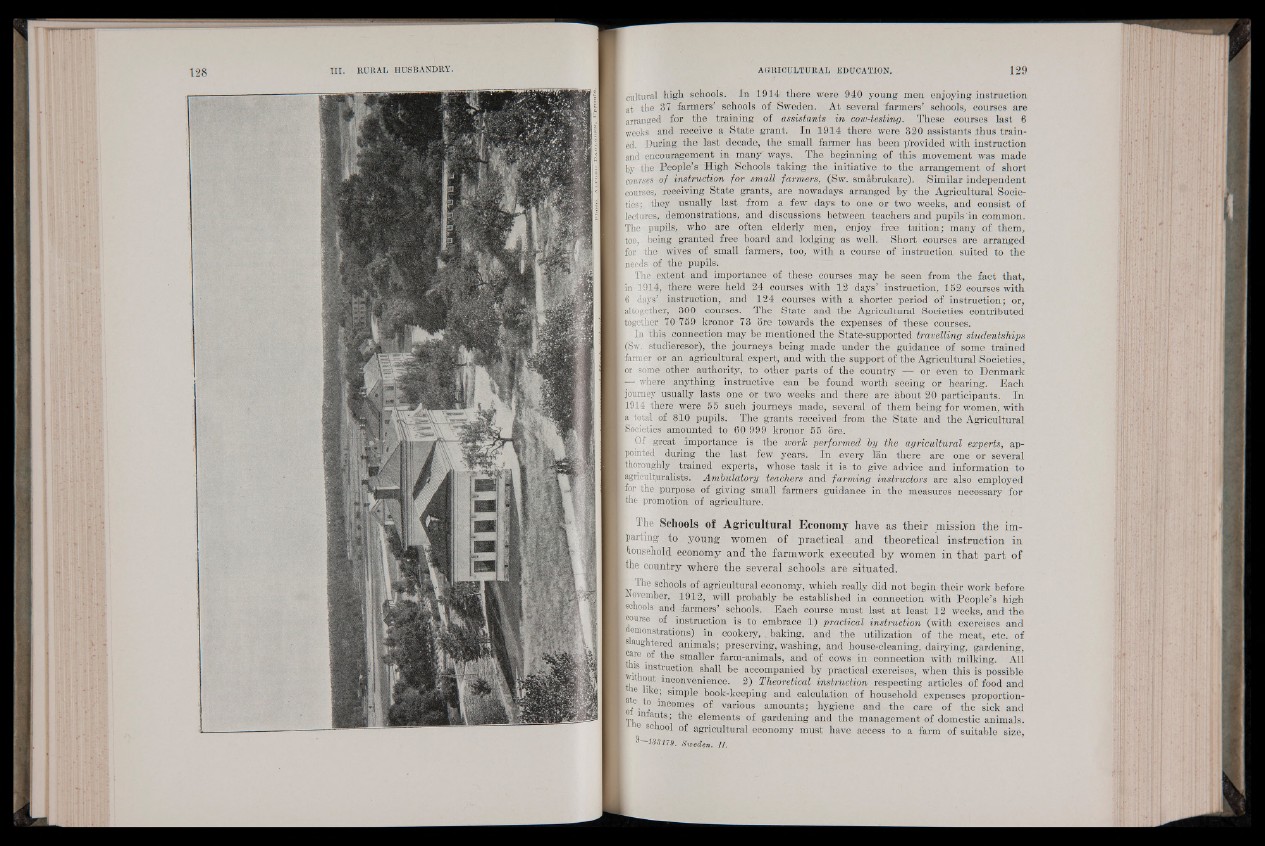
cultural high schools. In 1914 there were 940 young men enjoying instruction
at the 37 farmers’ schools of Sweden. At several farmers’ schools, courses are
arranged for the training of assistants in cow-testing. These courses last 6
weeks and receive a State grant. In 1914 there were 320 assistants thus trained.
During the last decade, the small farmer has been provided with instruction
and encouragement in many ways. The beginning of this movement was made
by the People’s High Schools taking the initiative to the arrangement of short
courses of instruction for small farmers, (Sw. smâbrukare). Similar independent
‘courses, receiving State grants, are nowadays arranged by the Agricultural Societies;
they usually last from a few days to one or two weeks, and consist of
lectures,, demonstrations, and discussions between teachers and pupils in common.
The pupils, who. are often elderly men, enjoy free tuition; many of them,
too, being granted free board and lodging as well. Short courses are arranged
for the wives of small farmers,. too, with a course of. instruction suited to the
ineeds of the pupils.
[ The extent and importance of these courses may be seen from the fact that,
in 1914, there were-held 24 courses with 12 days’ instruction, 152 courses with
6 days’ instruction, and 124 courses with a shorter period of instruction; or,
¡altogether, 300 courses. The State and the Agricultural Societies contributed
[together 70 759 kronor 73 ore towards the expenses of these courses.
} In thi§ connection may be mentioned the State-supported travelling studentships
E(Sw. studieresor), the journeys being made under the guidance, of some trained
former or an agricultural expert, and with the support of the Agricultural Societies,
or some other authority, to other parts of thé country or even to Denmark
[—■ where anything instructive can be found worth seeing or hearing. Each
ijoumey usually lasts one or two weeks and there are about 20 participants. In
1914 there were 55 such journeys made, several of them being for women, with
a total of 810 pupils. The grants received from the State and the Agricultural
¡Societies amounted to 60 999 kronor 55 ore.
I Of great importance is the work performed hy the agricultural experts, appointed
during the last few years. In every lan there are one or several
thoroughly trained experts, whose task it is to give advice and information to
(agriculturalists. Ambulatory teachers and farming instructors are also employed
for the purpose of giving small farmers guidance in the measures necessary for
!the promotion of agriculture.
The Schools of Agricultural Economy have as their mission the imparting
to young women of practical and theoretical instruction in
jnousehold economy and the farmwork executed by women in that part of
phe country where the several schools are situated.
t The schools of agricultural economy, which really did not begin their work before
I “Tember, 1912, will probably be established in connection with People’s high
[schools and farmers’ schools. Each course must last at least 12 weeks, and the
purse of instruction is to embrace 1) practical instruction (with exercises and
¡demonstrations) in cookery, baking, and the utilization of the meat, etc. of
¡slaughtered animals; preserving, washing, and house-cleaning, dairying, gardening,
pare of the smaller farm-animals, and of cows in connection with milking. All
I '(I lns^'uc^ 031 shall be, accompanied by practical exercises, when this is possible
[th ü ji Theoretical instruction respecting articles of food and
| te 7 Y s™Ple book-keeping and calculation of household expenses proportion-
p e to incomes of various amounts; hygiene and the care of the sick and
Th ?ts; B e lu e n t s of gardening and the management of domestic animals.
I e school of agricultural economy must have access to a farm of suitable size,
I ^ 133179. Sweden. II.